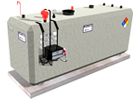Specification Information
- The Insulated Secondary Containment Aboveground Storage Tank Systems for Flammable and Combustible Liquids, Protected Type: Vehicle Impact Protected, and Projectile Resistant shall be tested to and listed for the following:
- UL - 142, aboveground steel tanks for flammable and combustible liquids.
- UL - 2085, two-hour furnace fire test and two hour simulated pool fire test for insulated and protected tanks.
- UL - 2085 and UFC Test Standard (Article 79 or APPENDIX #A-II-F-1), for both Vehicle Impact Protection and Projectile Resistance.
- UL - 2085, Protected aboveground tanks for flammable and combustible liquids.
- UL - 2085, Non-Metallic Secondary Containment protected tanks for flammable and combustible liquids with secondary containment Emergency Venting by "Form of Construction".
- CAN/ULC - S601 (ORD - 142.18), Standard for shop fabricated steel aboveground horizontal tanks for flammable and combustible liquids.
- CAN/ULC - S655 (ORD - C 142.16), Standard for protected aboveground tank assemblies for flammable and combustible liquids
- CAN/ULC - (ORD - C 142.5), Standard for concrete encased aboveground tank assemblies for flammable and combustible liquids.
- CAN/ULC - (ORD - C 142.16), the furnace burn requirements for two hour fire rating.
- CAN/ULC - (ORD - C 142.25), the open (pool) fire testing for two-hour flammable liquid fire test.
- CAN/ULC - (ORD - 142.23), for aboveground tanks for used oil.
- The requirement for Uniform Fire Code (UFC) for two-hour (firewall) test.
- To be tested and certified by the California Air Resources Board (CARB) for Balanced Phase 1 and Phase 2 Vapor Recovery including methanol and ethanol.
- High Explosive (HE) Blast Resistance: The tank system design shall be the subject of a Blast Effects Analysis (BEA) for resistance under the following blast threat load scenarios:
- a 50-pound HE man-portable improvised explosive device (MPIED) at the standoff distance of 5 feet;
- a 500-pound HE vehicle-born improvised explosive device (VBIED) at the standoff distance of 20 feet; and
- a vapor cloud explosion (VCE) with a load of 10 psi.
- The primary steel tank shall be rectangular in shape and have continuous welds on all exterior seams, manufactured in accordance with UL listing requirements and UL Standard 142.
- The primary steel tank shall be pressure tested at 5 psig for 24 to 48 hours.
- The primary steel tanks shall have "emergency vent" system as per NFPA 30 Code requirements.
- The protected and insulated AST systems shall have a thru-tank leak detector tube to allow for physical checkup and monitoring capability between the primary and the secondary containment.
- The primary steel tank shall be pressurized at 5 psig during concrete encasement.
- The outer surface of the primary steel tank shall be covered by a minimum of 1/4" thick (6.4 mm) Styrofoam insulation panels.
- The secondary containment shall consist of a 30 Mil thick (0.76 mm) High-Density Polyethylene membrane enclosing the steel tank and insulation material.
- The primary steel tank and the secondary containment shall be encased in six inches of monolithic reinforced concrete, with minimum design strength of 4,000 and 5,000 psi at 28 days depending on the tank size. The concrete design shall include the following for long-term durability: air entrainment, water reducing admixture, and steel reinforcement. Concrete encasements with seams will not be approved.
- The protected and insulated AST systems shall be of concrete exterior and a continuous and visually verifiable monolithic (seamless) pour on top, bottom, ends, and sides and contain no cold joints or heat sinks (heat transfer points). The AST must be shop fabricated and tested in accordance with the UL listings. Designs that use two layers of steel with insulation material between them will not be approved.
- No steel or insulating material shall come in contact with the concrete or other corrosive material.
- All openings shall be from the top only.
- All exposed metal with the exception of stainless steel must be powder coated to inhibit corrosion.
- The protected and insulated AST systems shall include a 7 or 15-gallon powder coated or stainless steel, UL listed spill containment, and shall include normally closed valve to release spilled product into the primary steel tank. Spill containment which route the spilled product into interstitial area will not be approved.
- The protected and insulated AST systems shall have a coated concrete exterior to resist weather and reflect sunlight. Models with steel exteriors will not be approved.
- The protected and insulated AST systems shall have a warranty of 30 years for systems 2,000 gallon capacity and larger and 20 years for systems 1,000 gallon capacity and smaller with optional 30-year warranty.
- The protected and insulated AST systems design shall have been in use for a minimum of twenty (20) years. The manufacturer must stipulate no reportable AST containment system failure in 30,000 units produced.
- The protected and insulated AST systems shall have two (2) bolts for connecting grounding conductors for lightning protection in accordance with NFPA 780.
The BEA shall conclude that the tank system shall resist the explosion loads and remain intact, without failure of the primary tank. The engineering consultants performing the BEA shall be a nationally recognized firm with over 10 years experience offering comprehensive services related to blast and impact effects analysis, explosive safety design, vulnerability assessments and threat mitigation.






